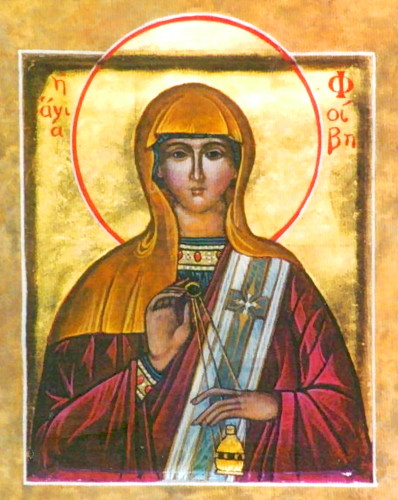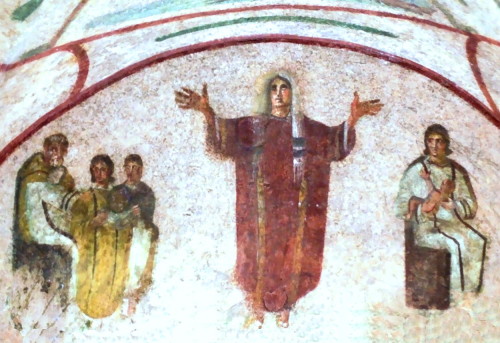- Home
- Membership
- Women in Clergy
Women in Classical Clergy:
Women Clergy & Female Bishops of Apostolic Succession
 In the 12th century Ancient Apostolic Church of the 1st century denomination of Ancient Catholicism, women hold full and equal status in the Ancient Catholic Clergy, at all levels, and are canonically consecrated as Bishops (Genesis 1:26-28; Mark 15:40-41; Acts 1:14; Romans 16:1; I Corinthians 11:8-12) [1].
In the 12th century Ancient Apostolic Church of the 1st century denomination of Ancient Catholicism, women hold full and equal status in the Ancient Catholic Clergy, at all levels, and are canonically consecrated as Bishops (Genesis 1:26-28; Mark 15:40-41; Acts 1:14; Romans 16:1; I Corinthians 11:8-12) [1].
Jesus the Nazarene was a High Priest of the Egyptian Nazarene Essenes [2] [3] [4] [5]. The “Wisdom Texts” of the Essene scrolls describe in great detail “the search for Wisdom as a female figure”, establishing doctrines of the feminine aspects of God [6]. As a result, in the Essene Priesthood women were given initiatory training [7], and the 1st century historian Flavius Josephus documented that women were given formal initiation as Priestesses, equal to the men [8]. The historical record contains extracanonical manuscripts of the Apostles, preserved by the 1st century Essenes, which evidence that the Apostles continued this same doctrine [9], indicating that women were equally consecrated as Bishops.
In the New Testament, Saint Paul wrote of a woman named Phoebe, identifying her as ordained Clergy, but describing her serving as a key envoy, in a role equivalent to the rank of Monsignore (higher than Priest): “I commend to you our sister Phoebe, a Deacon of the Church” (Romans 16:1). Confirming her importance as much more than Clergy, Phoebe is a canonized Saint in both the Roman Catholic and Orthodox denominations.
Father Scott Brodeur, a Jesuit Professor of the Vatican Pontifical Gregorian University in Rome, explains the Biblical context and significance of Saint Phoebe: “Paul, by sending her to Rome, is saying ‘look at this extraordinary woman, and I’m sending you one of our best, and because I trust her, she’s going to interpret this letter for you, so if you have any questions, ask Phoebe’. … Paul is so aware of the importance of this letter, so she has a crucial role. … The entire letter to the Romans is about [this] common equality among us, that we all share the same value and worth. … Women were essential in the early Church.” [10]
The historical record establishes that during the 1st – 2nd century, women were active and often equal co-founders and leaders of the early Church [11], women hosted and led prayer meetings in their homes, and at least 50% of the Churches in Rome were founded by women [12].
The 2nd – 4th century underground Catacombs of Saint Priscilla in Rome feature a large mural painting of women presiding over a sacrament resembling the Eucharist as Holy Communion. A nearby alcove features a painting of a woman wearing a white alb vestment which could only be worn by ordained Priests, being administered to by a Bishop, with a larger woman depicted in the center overseeing the ceremony appearing to be leading prayer. [13] The chamber is actually named after this 3rd century painting, referred to by Vatican historians as the “Room of the Veiled Woman”.
The 9th century Zenon Chapel of the Santa Prassede (Saint Praxedis) Basilica in Rome features a mosaic of four women, the Virgin Mary with two female Saints, and another woman (on the left), who is prominently labeled by the word ‘Episcopa’, the specific feminine grammatical form for a Female Bishop, with her name “Theodora”. Confirming this as the literal Episcopal title, her shoulders are adorned with Clergy insignia. [14]
Saint Mary Magdalene is widely attributed with holding a special status as the primary Disciple of Jesus, who the Gnostics considered to be one of the Apostles. This was confirmed by the authoritative Vatican theologian Saint Augustine (ca. 400 AD) recognizing her with the honorary title “Apostle to the Apostles”. [15] The name “Magdalene” did not mean merely “from Magdala”, but actually meant “The Tower”, as Mary’s nickname and title of prominence and importance among the Apostles. [16]
Saint Thecla (b. 30 AD) was the Disciple of the Apostle Peter, considered by the Gnostics to also be an Apostle similar to Mary Magdalene [17]. The 2nd century extracanonical scripture, the Lost Gospel “Acts of Paul and Thecla”, leads some ecclesiastical scholars to view the female Disciple Thecla as “an image of what it really [means] to listen to the Word of God. … There is a lot of evidence that women played a different role in the early Christian communities, that they were seen as equal sharers in the job of preaching and teaching.” [18]
Vatican experts note that as the founding Royal Patronage of the Order of the Temple of Solomon (Knights Templar) from its inception, “the Kingdom of Jerusalem [was] a feudal kingdom transmissible through women”. As it was the proper lineage of canonical succession for reestablishment of the Grand Mastery, this establishes that the Ancient Priesthood of Solomon of the Templar Order can also be carried by female lines. [19] This Vatican recognition confirms that the Episcopal lineage of the 1st century denomination of Ancient Catholicism, of the 12th century Ancient Apostolic Church restored by the Knights Templar, does canonically pass through female Bishops, for valid Apostolic Succession.
Suggested Topics Related to this Information
–
Click to learn about the Ancient Apostolic Church as a Pontifical institution.
Click for details of the Apostolic Succession Lines within Ancient Catholicism.
Click for a full report on the Ancient Apostolic Denomination of the Templars.
Click to learn about Clergy Roles & Functions in Ancient Catholicism.
–
Academic Source References for this Topic
[1] The Holy Bible, Authorized King James Version (AKJV), Cambridge University Press (1990): God gave men and women both dominion, equally and jointly together, not separately: “Let them have dominion… male and female… and God said unto them… have dominion” (Genesis 1:26-28); “Mary Magdalene… followed him [Jesus] and ministered unto him.” (Mark 15:40-41); “These all continued with one accord in prayer and supplication, with the women” (Acts 1:14); Apostle Paul: “I commend to you our sister Phoebe, a Deacon of the Church” as an Apostolic delegate (Romans 16:1); “For this cause ought the woman to have power on her head because of the Angels. … neither is the man without the woman, neither the woman without the man, in the Lord… but all things of God.” (I Corinthians 11:8-12).
[2] H. Spencer Lewis, The Mystical Life of Jesus, Ancient and Mystical Order Rosae Crucis, San Jose (1982).
[3] New Testament, Authorized King James Version (AKJV), Cambridge University Press (1990), Acts 24:5: “For we have found this man [Saint Paul] a pestilent fellow, and a mover of sedition among all the Jews throughout the world, and a ringleader of the sect of the Nazarenes.” (This conclusively proves that the Nazarenes, and thus also the Essenes, were never “Jewish”, as is widely and frequently claimed, but rather exclusively pre-Christian and early Christian, and wholly rejected by Judaism.)
[4] Frank Ely Gaebelein (Editor), The Expositor’s Bible Commentary: with the New International Version, 12 Volume Set, Zondervan Press (1988): The Gospel of “Matthew certainly used Nozaraios as an adjectival form of apo Nazaret (‘from Nazareth’ or ‘Nazarene’) even though the more acceptable adjective is Nazarenos” (Nazarene), which is correctly used elsewhere in the New Testament.
[5] Professor Ted Nottingham, The Mystery of the Essenes, Video of Lecture at Northwood Christian Church, Indianapolis Indiana (2010), at 24:04 and 26:00 min.
[6] Schiffman & VanderKam, Encyclopedia of the Dead Sea Scrolls, Oxford University Press (2000), Vol.2, p.977, “Wisdom Texts”, citing Qumran Scroll 11Q5 xxi.11-17; xxii.1.
[7] Schiffman & VanderKam, Encyclopedia of the Dead Sea Scrolls, Oxford University Press (2000), Vol.2, p.983, “Women: Membership, Leadership and Status”, citing Qumran Scroll 1Q28a i.4.
[8] Schiffman & VanderKam, Encyclopedia of the Dead Sea Scrolls, Oxford University Press (2000), Vol.2, p.983, “Women: Membership, Leadership and Status”, citing Flavius Josephus, The Jewish War, 2.161.
[9] Montague Rhodes James, The Apocryphal New Testament, Oxford University Press (1707), Clarendon Press, Oxford (1924), Acts of Thomas, 27.
[10] Rodgers, Orazi & Julian, Divine Women: Handmaids of the Gods, documentary film, BBC Productions (2012), at 45:10 min.
[11] Dr. Jonathan L. Reed, Science of the Bible: The Real Mary Magdalene, documentary film, National Geographic (2005), at 39:20 min.
[12] Al Rodgers, Andrea Orazi & Oliver Julian, Divine Women: Handmaids of the Gods, Part 2 of documentary film series, presented by Bettany Hughes, BBC Productions (2012), at 41:00 minutes.
[13] Rodgers, Orazi & Julian, Divine Women: Handmaids of the Gods, documentary film, BBC Productions (2012), at 43:15 minutes.
[14] Rodgers, Orazi & Julian, Divine Women: Handmaids of the Gods, documentary film, BBC Productions (2012), at 47:00 min.
[15] Ken Doyle, Apostle to the Apostles: The Story of Mary Magdalene, Catholic Times, 11 September 2011.
[16] Lori Nelson, Secrets of Mary Magdalene, documentary film, Discovery Channel (2006), at 4:30 min.
[17] Acts of Paul and Thecla, Vercelli Library, Italy; Banned from the Bible, documentary film, The History Channel (2007), at 8:45 min.
[18] Rodgers, Orazi & Julian, Divine Women: Handmaids of the Gods, documentary film, BBC Productions (2012), at 38:45 min.
[19] The Vatican, The Catholic Encyclopedia (1912), The Encyclopedia Press, New York (1913), Volume 14, “Templars, Knights”, Part 2, “Their Marvellous Growth”, p.494.
[wptb id=3527]


